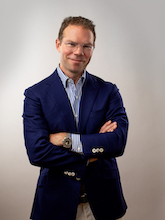
















Eight years ago, before the TSA began scanning passengers’ privates as a matter of course, Wade Eyerly was working as an advance man for Vice President Dick Cheney, traveling 27 days a month on last-minute, one-way tickets. Naturally, that buying pattern put him at the top of every screener’s watch list. So even though he could get close enough to the vice president to hug him (assuming the veep did hugs), he couldn’t board a plane without a pat-down. “Clearly, something was wrong with the system,” Eyerly says today. “And when something is that wrong, we should fix it.”
In Eyerly’s mind, fixing air travel meant starting an airline that opts out of the TSA and tickets altogether. The result is Surf Air, the first all-you-can-fly carrier. For $1,000 a month, members will be able to travel anywhere on Surf Air’s system as often as they’d like. Beginning at the end of 2012 (pending FAA approval), the airline will link four California regions—Los Angeles, Santa Barbara, Monterey, and the San Francisco area—using eight-seat planes outfitted like private jets. From there, it plans to expand regionally and then nationally, connecting short-hop city pairs such as Seattle-Portland or Dallas-Austin and avoiding congested hubs in favor of small airfields with no waits and no bureaucrats.
With its regional focus and fleet of puddle-jumpers, Surf Air poses little threat to the current titans of the skies. Despite a growing number of consumer complaints, the past three years have been among the best in the U.S. airline industry’s history—it raked in a record-breaking $10.5 billion in operating profits in 2010, according to the Bureau of Transportation Statistics, and $7.1 billion last year. But Surf Air does raise a big question: In a hopelessly sclerotic industry that nevertheless produces billions in profits, why aren’t more companies taking a run at the incumbents?
Working in Surf Air’s favor is that unlike previous upstarts such as JetBlue—whose founder raised $128 million at the outset to buy jets—it’s the first airline launched like an app. Eyerly and his brother Dave (a pilot and former TSA employee) took their idea to MuckerLab in Los Angeles and graduated last spring with $4 million in venture capital, led by Santa Monica’s Anthem Venture Partners. They borrowed their business model from Netflix, and all bookings will be handled via apps and online. The actor-musician Jared Leto, who has invested in Surf Air, compares the airline to Uber, the taxi-summoning service.
Technically, Surf Air isn’t even an airline. The FAA considers it a charter service with permission to fly on regular schedules, so it will be exempt from TSA scrutiny. Surf Air will fly where airlines don’t—from Santa Monica Municipal Airport, say, rather than LAX. As Eyerly points out, 90% of America’s nearly 20,000 airfields operate well below capacity. “It’s an interstate highway system without any cars,” he says.
Surf Air clients will encounter no friction before flights. An iPad-wielding concierge will greet them at the airfield. Then they will walk to the plane—a Pilatus PC-12, which has the legroom of a Learjet but consumes considerably less fuel. Besides flying as often as they wish, members can travel at the last minute without penalty. Echoing Netflix’s DVD subscription model, the only limit is the number of one-way reservations members may hold at a time (six).
Surf Air plans to launch with no more than 500 members, each paying $1,000 a month. Membership will be capped for three months as the airline gets a handle on passenger behavior. “You’re looking at an airline built for frequent fliers,” says Eyerly. “There’s no data that says what will happen when their per-flight costs drop to zero. The only way to get it is to fly.”
There does seem to be a market—nearly 50,000 “supercommuters” regularly fly or drive between the Bay Area and Los Angeles, according to New York University’s Mitchell Moss. And even cynical aviation analysts concede the all-you-can-fly model has merit. “It’s an interesting experiment,” says Teal Group vice president Richard Aboulafia, although the price doesn’t make sense to him. “Profits would be eaten up fast,” he says. Other analysts predict the price will rise as Surf Air tweaks its model.
Cutting costs is what created an opening for Surf Air in the first place. The major carriers are saving money with what is, at the moment, a winning formula: fewer routes, tighter planes, and hidden charges. As the experience for passengers has worsened, profits have swelled. U.S. carriers effectively break even on airfares while earning nearly all of their profits from nickel-and-diming passengers; in the first half of 2012, ticket and baggage fees totaled more than $3 billion. These are a textbook example of what Bain & Co.‘s Fred Reichheld has labeled “bad profits”—the kind earned from abusing customers rather than creating value for them. The upside of bad profits, Reichheld writes, is that sooner or later they will inspire someone to disrupt them—consider how Blockbuster’s punitive late fees created an opening for Netflix. Yet few entrepreneurs are trying to take advantage of the pent-up frustration with air travel.
The reason is that major airlines pounce when they see turf worth having. As ill-fated air-taxi pioneers like Pogo, DayJet, and SATSair learned nearly a decade ago, once an upstart begins having success with an underserved route, larger carriers will come in, often operating at a loss, and push them out. “Your model has to scale immediately and be disruptive out of the box,” says DayJet founder Ed Iacobucci. “Otherwise, the airlines will come down hard on you.”
Surf Air may soon discover this for itself. Already, a former Google engineer named Shawn Simpson has quietly formed Boutique Air, relying on the same FAA loophole, the same market (northern California and the Pacific Northwest), and the same strategy (flying to small airports with small planes).
Perhaps a new model of air travel requires a more fundamental disruption. Bruce Sawhill, a physicist who worked for Iacobucci, suggests that one cost bottleneck is in the cockpit—two pilots for a half-dozen passengers is too expensive. “Something like DayJet will work under certain circumstances,” Sawhill says, “but it will only work big-time when planes are electric and robotic.” Anyone want to book a ticket on Drone Air?

» Folllow me on Twitter.
» Email me.
» See upcoming events.

Greg Lindsay is a generalist, urbanist, futurist, and speaker. He is a non-resident senior fellow of the Arizona State University Threatcasting Lab, a non-resident senior fellow of MIT’s Future Urban Collectives Lab, and a non-resident senior fellow of the Atlantic Council’s Scowcroft Strategy Initiative. He was the founding chief communications officer of Climate Alpha and remains a senior advisor. Previously, he was an urban tech fellow at Cornell Tech’s Jacobs Institute, where he explored the implications of AI and augmented reality at urban scale.

----- | January 22, 2024
The Future of Generative AI in Architecture, Engineering, and Construction
----- | January 1, 2024
----- | August 3, 2023
CityLab | June 12, 2023
Augmented Reality Is Coming for Cities
CityLab | April 25, 2023
The Line Is Blurring Between Remote Workers and Tourists
CityLab | December 7, 2021
The Dark Side of 15-Minute Grocery Delivery
Fast Company | June 2021
Why the Great Lakes need to be the center of our climate strategy
Fast Company | March 2020
How to design a smart city that’s built on empowerment–not corporate surveillance
URBAN-X | December 2019
CityLab | December 10, 2018
The State of Play: Connected Mobility in San Francisco, Boston, and Detroit
Harvard Business Review | September 24, 2018
Why Companies Are Creating Their Own Coworking Spaces
CityLab | July 2018
The State of Play: Connected Mobility + U.S. Cities
Medium | May 1, 2017
Fast Company | January 19, 2017
The Collaboration Software That’s Rejuvenating The Young Global Leaders Of Davos
The Guardian | January 13, 2017
What If Uber Kills Public Transport Instead of Cars
Backchannel | January 4, 2017
The Office of the Future Is… an Office
New Cities Foundation | October 2016
Now Arriving: A Connected Mobility Roadmap for Public Transport
Inc. | October 2016
Why Every Business Should Start in a Co-Working Space
Popular Mechanics | May 11, 2016
Can the World’s Worst Traffic Problem Be Solved?
The New Republic | January/February 2016

January 31, 2024
Unfrozen: Domo Arigatou, “Mike 2.0”
January 22, 2024
The Future of Generative AI in Architecture, Engineering, and Construction
January 18, 2024
The Promise and Perils of the Augmented City
January 13, 2024